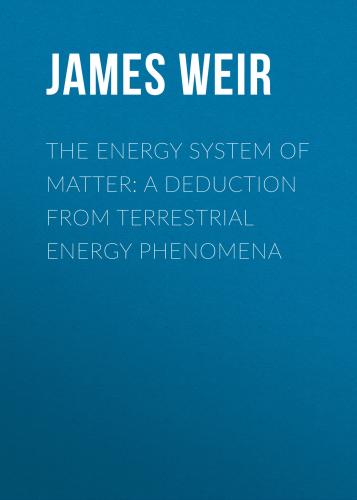16. Terrestrial Gravitation as an Incepting Influence
The attractive influence of gravitation appears as an incepting agency in terrestrial as well as in celestial phenomena. In fact, of all the agencies which incept energy transformations on the earth, gravitation, in one form or another, is the most universal and the most important. Gravitation being a property of all matter, no mundane body, animate or inanimate, is exempt from its all-pervading influence, and every movement of energised matter within the field of that influence leads inevitably to energy transformation.
Let us take a concrete illustration. A block of solid material is supported on a horizontal table. By means of a cord attached, energy is applied to the block from an external source, so that it slides over the surface of the table. As a result of this motion and the associated frictional process, heat energy will make its appearance at the sliding surfaces of contact. This heat energy is obviously obtained by the transformation of that energy originally applied to the block from the external source. What is the incepting influence in this process of transformation? The incepting influence is clearly the gravitative attraction of the earth operating between the moving block and the table. The frictional process, it is well known, is dependent in extent or degree on the pressure between the surfaces in contact. This pressure is, of course, due to the gravitative attraction of the earth on the mass of the block. If it be removed, say by supporting the block from above, the heat-transformation process at the surfaces at once terminates. Gravity, then, is the primary incepting influence of the process. The effect of gravitation in transformation has apparently been eliminated by supporting the block from above and removing the pressure between block and table. It is not really so, however, because the pressure due to the gravitative attraction of the earth on the block has in reality only been transferred to this new point of support, and if a movement of the block is carried out it will be found that the heat transformation has been also transferred to that point. But there are also other influences at work in the process. The extent of the heat transformation depends, not only on the pressure, but also on the nature of the surfaces in contact. It is evident, that in the sliding movement the materials in the neighbourhood of the surfaces in contact will be more or less strained or distorted. This distortion is carried out in the lines of the cohesive forces of the materials, and is the real mechanism of the transformation of the applied work energy into heat. It is obvious that the nature of the surfaces in contact must influence the degree of distortion, that is, whether they are rough or smooth; the cohesive qualities of the materials in contact will depend also on the nature of these materials, and the extent of the heat transformation will be limited by these cohesive properties in precisely the same way as described for other examples (§ 15). The function of gravitation in this transformation is, obviously, again quite passive in nature, and is in no way influenced by the extent of the process. Gravitation is, as it were, only the agency whereby the acting energy is brought into communication with the cohesive forces of the sliding materials.
Конец ознакомительного фрагмента.
Текст предоставлен ООО «ЛитРес».
Прочитайте эту книгу целиком, купив полную легальную версию на ЛитРес.
Безопасно оплатить книгу можно банковской картой Visa, MasterCard, Maestro, со счета мобильного телефона, с платежного терминала, в салоне МТС или Связной, через PayPal, WebMoney, Яндекс.Деньги, QIWI Кошелек, бонусными картами или другим удобным Вам способом.
